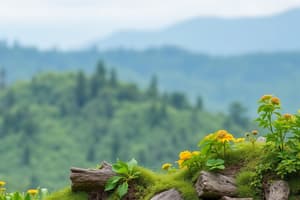Podcast
Questions and Answers
Which of the following best defines an ecosystem?
Which of the following best defines an ecosystem?
- All the living and non-living things in a given area and their interactions. (correct)
- A group of organisms of the same species living in the same area.
- The total number of species in a habitat.
- The climate conditions of a specific region.
Biotic factors are non-living components that influence the survival and reproduction of organisms.
Biotic factors are non-living components that influence the survival and reproduction of organisms.
False (B)
Name three examples of abiotic factors that can affect organisms in an ecosystem.
Name three examples of abiotic factors that can affect organisms in an ecosystem.
Air, water, soil, sunlight
Organisms require an ______ range of abiotic conditions to survive and reproduce.
Organisms require an ______ range of abiotic conditions to survive and reproduce.
Match each item with the appropriate category:
Match each item with the appropriate category:
Which of the following is an example of organisms competing for an abiotic factor?
Which of the following is an example of organisms competing for an abiotic factor?
Competition for biotic factors only occurs between individuals of the same species.
Competition for biotic factors only occurs between individuals of the same species.
List three examples of biotic factors that organisms compete for.
List three examples of biotic factors that organisms compete for.
Outside the optimum range of abiotic conditions, an organism's growth and development may be ______.
Outside the optimum range of abiotic conditions, an organism's growth and development may be ______.
Match the following terms with their correct definitions:
Match the following terms with their correct definitions:
Which of the following abiotic factors is most essential for photosynthesis?
Which of the following abiotic factors is most essential for photosynthesis?
An ecosystem consists only of the living organisms in a particular area.
An ecosystem consists only of the living organisms in a particular area.
Explain how competition for mates can affect the survival of a species.
Explain how competition for mates can affect the survival of a species.
The availability of ________ is a common limiting factor for plant growth in terrestrial ecosystems.
The availability of ________ is a common limiting factor for plant growth in terrestrial ecosystems.
Match each organism with the resource it most likely competes for:
Match each organism with the resource it most likely competes for:
Which scenario exemplifies competition for protection as a biotic factor?
Which scenario exemplifies competition for protection as a biotic factor?
If abiotic conditions are within the optimum range, growth and development of an organism will always be unlimited.
If abiotic conditions are within the optimum range, growth and development of an organism will always be unlimited.
Provide an example of how humans can influence both biotic and abiotic factors in an ecosystem.
Provide an example of how humans can influence both biotic and abiotic factors in an ecosystem.
The study of how organisms interact with each other and their environment is called ______.
The study of how organisms interact with each other and their environment is called ______.
Match each of the examples to whether it is biotic or abiotic:
Match each of the examples to whether it is biotic or abiotic:
Flashcards
Ecosystem
Ecosystem
All the living and non-living things in a given area, and their interactions.
Biotic Factors
Biotic Factors
Living or once-living factors that affect the survival and reproduction of organisms.
Abiotic Factors
Abiotic Factors
Non-living factors that affect the survival and reproduction of organisms.
Dependence and Competition
Dependence and Competition
Signup and view all the flashcards
Abiotic factors organisms compete for
Abiotic factors organisms compete for
Signup and view all the flashcards
Biotic factors organisms compete for
Biotic factors organisms compete for
Signup and view all the flashcards
Study Notes
- An ecosystem constitutes all living and non-living entities within it, emphasizing their interactions.
Biotic Factors
- Living organisms or those that were once living influence the survival and reproduction of organisms.
- Humans, animals, plants, and fungi serve as examples.
Abiotic Factors
- Non-living elements impact the survival and reproduction of organisms.
- Air, water, soil, and sunlight are examples.
Dependence and Competition
- An optimal range of abiotic conditions is vital for living organisms to survive and reproduce.
- Growth and development may be restricted outside the optimal range.
Competition for Abiotic Factors
- Organisms compete for abiotic factors like the atmosphere, space, water, air, and temperature.
Competition for Biotic Factors
- Organisms compete for biotic factors such as food, mates, and protection.
Studying That Suits You
Use AI to generate personalized quizzes and flashcards to suit your learning preferences.




